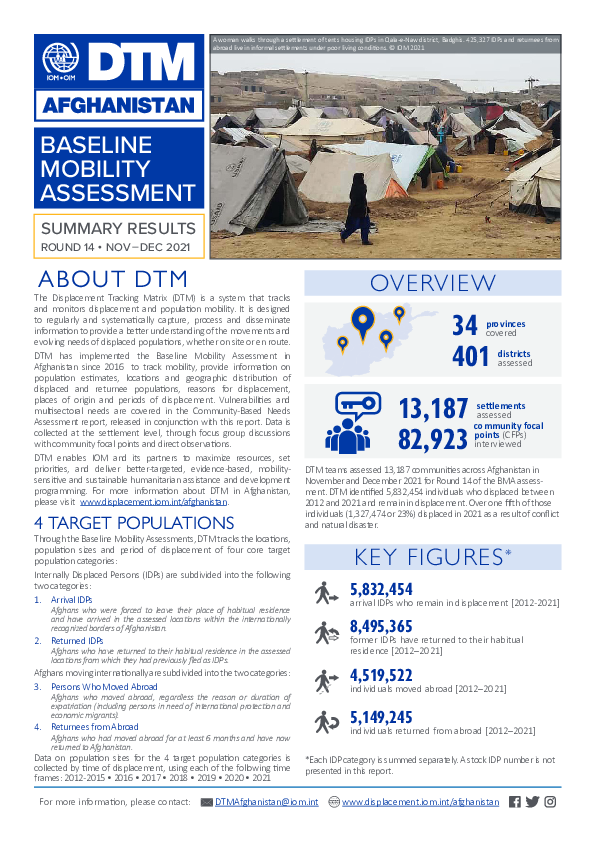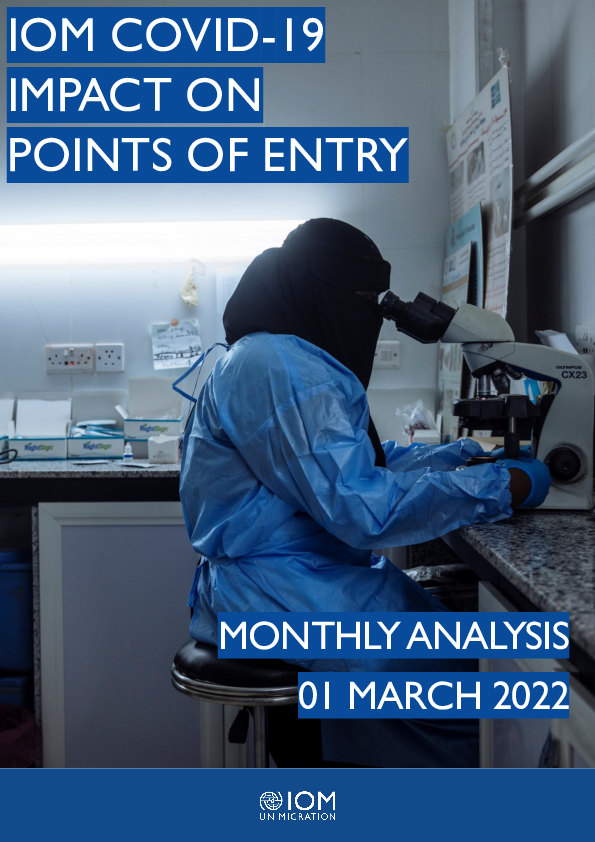-
Countries
-
Data and Analysis
-
Special Focus
-
Crisis Responses

Contact
DTMAfghanistan@iom.int
Language
English
Location
Afghanistan
Period Covered
Nov 01 2021
Dec 31 2021
Activity
- Mobility Tracking
- Site Assessment
In November through December 2021, DTM implemented the Community-Based Needs Assessment (CBNA) at the settlement level, as an integral component of DTM's Baseline Mobility Assessment (BMA), providing a comprehensive overview of the evolving, multi-sectoral needs in settlements hosting IDPs and returnees.

Contact
DTMAfghanistan@iom.int
Language
English
Location
Afghanistan
Period Covered
Nov 01 2021
Dec 31 2021
Activity
- Mobility Tracking
- Baseline Assessment
In Afghanistan, DTM employs the Baseline Mobility Assessment tool, designed to track mobility, determine the population sizes, locations and geographic distribution of forcibly displaced, return and migrant populations, reasons for displacement, places of origin, and times of displacement, as well as basic demographics, vulnerabilities and priority needs. Data is collected at the settlement level, through community focus group discussions with key informants and direct observations.
As of 31 December 2021, 34 provinces, 401 districts and 13,187 settlements have been assessed, including interviews with 82,923 community focal points. Between 2012 and December 2021, 5,149,245 returned migrants from abroad and 5,832,454 arrival IDPs currently living in host communities were identified.

Contact
DTM Nigeria, AllUsersInDTMNigeria@iom.int
Language
English
Location
Nigeria
Period Covered
Feb 14 2022
Feb 20 2022
Activity
- Event Tracking
- Mobility Tracking
Between 14 and 20 February 2022, a total of 2,131 movements were recorded in Adamawa and Borno States. The recorded movements consisted of 1,827 arrivals and 304 departures. Arrivals were recorded at locations in Askira/Uba, Bama, Gwoza and
Ngala Local Government Areas (LGAs) of the most conflict-affected State of Borno and in Fufore, Girei, Gombi, Hong, Lamurde, Maiha, Michika, Mubi North, Mubi South, Numan, Song, Yola North and Yola South LGAs of Adamawa State.
Departures were recorded in Askira/Uba and Bama LGAs of Borno, and in Fufore, Gombi, Hong, Maiha, Mubi South, Song and Yola North and Yola South LGAs of Adamawa State.

Contact
DTM Cameroun, DTMCameroon@iom.int
Language
French
Location
Cameroon
Period Covered
Nov 04 2021
Nov 12 2021
Activity
- Survey
- Return Intention
La Matrice de Suivi des Déplacements (Displacement Tracking Matrix – DTM, en anglais) est un outil mis en place par l’Organisation Internationale pour les Migrations (OIM), qui permet de faire le suivi des déplacements et la mobilité des populations. Elle collecte des informations à différents niveaux, les traite et les diffuse afin de garantir aux acteurs humanitaires, aux gouvernements et autres acteurs intéressés, une meilleure compréhension des mouvements et de l’évolution des besoins des populations déplacées : les facteurs d’influence, les moyens et durées de déplacement, les intentions futures des populations déplacées, leurs conditions de vie et encore bien d’autres éléments sont récoltés auprès de ces populations déplacées.
Ce rapport présente les résultats de la dernière enquête sur les intentions de retour menée auprès des ménages déplacés (Personnes Déplacées Internes (PDI) et réfugiés hors camp) en novembre 2021 dans 6 302 localités de la région de l’Extrême-Nord. Il permet ainsi de mieux comprendre le processus de décision des ménages déplacés, les raisons qui les poussent à partir ou les empêchent de revenir et les conditions nécessaires à un retour durable.

Contact
DTM Nigeria, AllUsersInDTMNigeria@iom.int
Language
English
Location
Nigeria
Period Covered
Feb 19 2022
Feb 25 2022
Activity
- Mobility Tracking
- Baseline Assessment
- Points of Entry (PoE)
During the COVID-19 pandemic, IOM's Displacement Tracking Matrix (DTM), in collaboration with the World Health Organization (WHO), monitors the movements to and from Nigeria's Adamawa and Borno States in north-east Nigeria. Assessments are conducted at Points of Entry located along the border with Cameroon.
During the period 19 - 25 February 2022, 206 movements were observed at three Points of Entry in Borno state. Of the total movements recorded, 66 were incoming from the Far North Region in Cameroon, while 25 were incoming from Bol and 1 from Ndjamena in Chad. One hundred and eleven outgoing movements were recorded from Borno State to the Far North Region in
Cameroon while three outgoing movement were recorded towards Bol in Chad.
A range of data was collected during the assessments to better inform on travellers’ nationalities, sex, reasons for moving, mode of transportation and timeline of movement as shown in figures 1 to 4 below:

Contact
DTM Nigeria, AllUsersInDTMNigeria@iom.int
Language
English
Location
Nigeria
Period Covered
Nov 16 2021
Dec 30 2021
Activity
- Site Assessment
- Mobility Tracking
This Round 9 of the COVID-19 Situation Analysis is based on the assessment of knowledge, practice and impact of the pandemic on internally displaced persons (IDPs) in conflict-affected communities of northeast Nigeria. Conducted by the Displacement Tracking Matrix (DTM) unit of the International Organization for Migration (IOM), the report covers the period between 16 November and 30 December 2022 and reflects trends from the states Adamawa, Bauchi, Borno, Gombe, Taraba and Yobe in north-east Nigeria.
The first assessment was conducted in May 2020, two months after the index case was reported in Nigeria. In this report, the results are presented from the 9th round of assessments. In this Round 9, 122,966 respondents - or 6 per cent of all identified IDPs as per DTM Round 40 - were interviewed for a range of COVID-19 related indicators. Key informant interviews and focus group discussions were the primary methods used for the assessment and the findings were corroborated with physical on-ground observations.

Contact
dtmcovid19@iom.int
Language
English
Location
Global
Period Covered
Mar 13 2020
Feb 24 2022
Activity
- Mobility Tracking
- Points of Entry (PoE)
IOM COVID-19 Impact on Points of Entry Monthly Analysis is meant to serve IOM Member States, IOM, UN and voluntary partner agencies, the civil society (including media) as well as the general population in analysing the impact of COVID-19 pandemic on Points of Entry. It is particularly relevant when identifying and addressing specific needs faced by migrants and mobile populations, disproportionately affected by global mobility restrictions. The report is based on information provided by IOM field staff, using resources available at the IOM country office level and is accurate to the best of IOM’s knowledge at the time of compilation. All information is being constantly validated, including the geolocation and attributes, and through regular assessments and triangulation of information. The updates depend on the time frame within which the information becomes available and is processed by IOM. For this reason, the analysis is always dated and timestamped in order to reflect reality at a given time. However, as the situation continuously evolves and changes, despite IOM’s best efforts, the analysis may not always accurately reflect the multiple and simultaneous restrictive measures being imposed at a specific location.

Contact
DTM Mauritania, DTMMauritania@iom.int
Language
French
Location
Mauritania
Period Covered
Dec 25 2021
Jan 08 2022
Activity
- Survey
- Migrants presence
- Mobility Tracking
Pour mieux connaitre les caractéristiques sociodémographiques des migrants à Chami et combler les besoins en termes d’informations sur ces populations migrantes afin de mieux planifier et orienter les programmes visant à apporter un soutien aux migrants dans les zones d’orpaillages, une enquête auprès d’un échantillon de 500 individus a été organisée par l’Agence Nationale de la Statistique et de l’Analyse Démographique (ANSADE), avec l’appui financier de de l’Organisation Internationale pour les Migrations (OIM) du 25 décembre 2021 au 08 janvier 2022 dans la moughataa de Chami à Dakhlett Nouadhibou.

Contact
iomiranmedia@iom.int
Language
Persian
Location
Iran (Islamic Republic of)
Period Covered
Jan 01 2020
Dec 31 2020
Activity
- Flow Monitoring
این تصویر اجمالی، خلاصه ای از داده های موجود در مورد اتباع ایرانی در اروپا در سال 2020 می باشد. صفحه اول، نمایانگر تعداد اتباع ایرانی وارد شده از طریق مرز های زمینی و دریایی به اتحادیه اروپا و کسانی که از طریق بالکان غربی و اروپای شرقی در سال 2020 وارد اروپا شده اند، می باشد. داده های مربوط به ورود و ترانزیت توسط مقامات ملی فرآهم گردیده و سپس توسط تیم DTM آژانس سازمان ملل در امور مهاجرت )IOM( در اروپا1، جمع آوری می شوند. جمع نبستن ارقام بسیار مهم است، زیرا این امر می تواند مستلزم شمارش دوبرابر مهاجرانی باشد که از طریق چندین کشور عبور کرده اند. صفحه دوم تعداد اتباع ایرانی مقیم اروپا را بر اساس جنسیت و منطقه واقع در اروپا را که توسط UNDESA گزارش شده است، نشان می دهد.
تصویر اجمالی مذکور، بخشی از خروجی های پروژه ماتریس رهگیری جا به جایی (DTM) تحت عنوان “شواهد منطقه ای برای بررسی و تحلیل مهاجرت” (REMAP)، که بودجه آن توسط اتحادیه اروپا فرآهم شده، می باشد. هدف DTM REMAP تقویت فرمول بنابر شواهد و اجرای سیاست ها و برنامه های بشردوستانه و توسعه در زمینه مهاجرت و جابجایی در افغانستان، بنگلادش، جمهوری اسلامی ایران، عراق و پاکستان می باشد.

Contact
DTM Nigeria, AllUsersInDTMNigeria@iom.int
Language
English
Location
Nigeria
Period Covered
Jan 01 2022
Jan 31 2022
Activity
- Event Tracking
The farmers and herders crisis in Nigeria, often mistaken for a crisis involving ethno religious conflicts, emanates from competing claims to natural resources These tensions are compounded by exponential population growth, expanding human settlements, land privatization, year round farming, environmental degradation, weakened traditional conflicts resolution mechanism and climate change These further weaken the adaptive capacities of involved parties and most often result in tensions between communities that sometimes lead to deadly conflicts. The COMITAS project contributing to the mitigation of conflict over natural resources between farmers and harders communities in Adamawa State, Nigeria is funded by the European Union ( through the Instrument contributing to Stability and Peace IcSP which responds to conflicts and crisis COMITAS intends to contribute to strengthen traditional conflict resolution, better trust in authorities, enhanced collaboration on natural resource management and improved intra and inter communal perceptions To this end, the Displacement Tracking Matrix (DTM)’s Transhumance Tracking Tool ( is a data collection and information management system which aims to provide a more comprehensive understanding of transhumance patterns, flows and trends, to identify profiles of cattle and herders, and inform on conflicts and other events related to transhumance movements.
